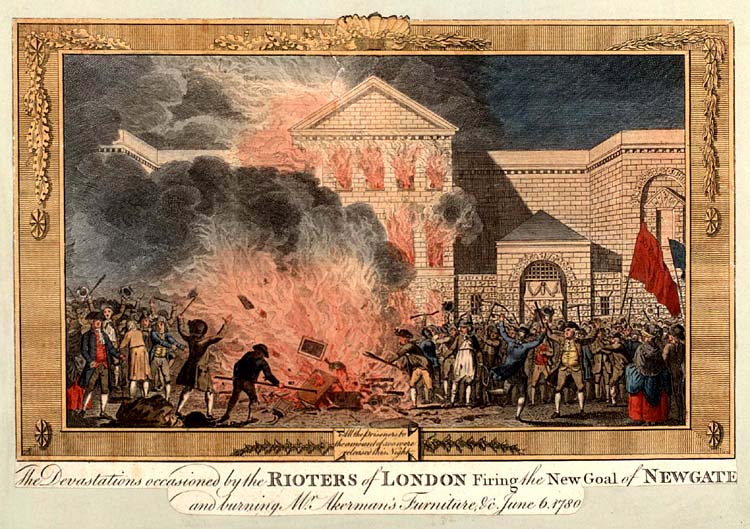A look at how previous riots in London have been depicted through art.

These are the worst social upheavals in London in living memory, say police. What about beyond living memory? The capital has seen some spectacular riots and rebellions. The early ones were not filmed or photographed, but can be seen in old paintings and prints.
In an illumination from a medieval manuscript of Froissart's Chronicles, the king and his lords in their pageantry confront an army of poor men in front of the towers and spires of London. The peasants' revolt in 1381 stormed into the capital and overran the Tower of London, whose defenders were massacred. The feudal nobility knew how to fight back. After the rebellion's leader Wat Tyler went to negotiate with the king he was stabbed to death – the nobles claimed he started it, and there were no mobile phone pictures to contradict their story – and the social order violently reimposed.

King Charles I was not so lucky in the 1640s, as his quarrel with parliament degenerated into war. In London, the radical Levellers staged debates on social justice at Putney. Anthony van Dyck's portrait of two aristocratic brothers, Lord John Stuart and Lord Bernard Stuart, in the National Gallery, conveys the scale of the conflict. The painting is a silken assertion of ruling-class hauteur; these young men in their lace and long hair seem born to rule. But they never did, because both were killed fighting on the royalist side in the civil war.
Neither the 1381 peasants' revolt nor the English civil war have much in common with the rioting and looting in London in August 2011, but there is far more of a parallel with the Gordon riots in 18th-century London. A contemporary print illustrating the destruction of Newgate prison during these massive riots in 1780 looks oddly familiar to anyone who has been looking at this week's images. The prison has been set on fire by the crowd and blazes uncontrollably. Meanwhile, prisoners escape and the prison is looted.


The Gordon riots were not pretty. The poor of 18th-century London lived on the edge, in a gin-sodden urban nightmare, if we are to believe William Hogarth's print Gin Lane. Desperation did not breed lofty ideals: the riots were provoked by a softening of the laws against Catholics. Bigoted rioters attacked foreign embassies and Catholic neighbourhoods. Yet the images eerily resemble London this week: in another 18th-century print, the crowd stoke a bonfire of furniture in front of the blazing hulk of Newgate, recognising, as rioters did this week, that furniture and furniture shops burn well.

The Gordon riots surely were the biggest in London's history to date. Hundreds of people were shot dead to bring the insurrection to a close. The cause of radicalism in Britain was hindered by the spectre of mob rule.
Looking at prints of the capital in flames in 1780 the contemporary parallels are striking. On this evidence, the riots of 2011 will take their place among the most epic upheavals in the entire history of London.
From The Guardian






Comments
I read a book many years ago
I read a book many years ago about the Clerkenwell riot. Can't remember what it was called but it was written by a cop that was on duty at the time so was heavily biased. I'm remember that a cop was killed in the middle of it all. I'm not sure where I got this from but I believe that only 2 cops have died during riots in the UK - this one and Kieth Blakelock during the Totenham riots in the 80s. I wonder how many protesters have bitten the dust? In more modern times I think there have been a few, Blair Peach springs to mind but it looks like your chances of snuffing it were pretty high - you wouldn't have been doing it for a bit of entertainment that's for sure!